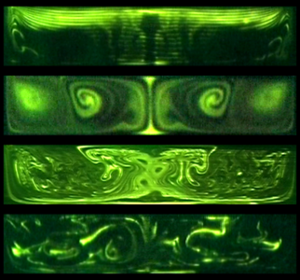Publié le 26 août 2025
–
Mis à jour le 10 septembre 2025
Date(s)
le 1 octobre 2025
15h00
Lieu(x)
Institut de Physique de Nice
Stairs first floor
Stairs first floor
Application of Open Quantum System Concepts to Internal Wave / Planetary Wave Coupling and consequences for Earth System Behavior
Fluid seminars
Abstract:
Abstract:
We assess a prognostic formulation of triple coherence relating to energy exchange between mesoscale eddies and the internal wavefield and compare with observations from the Sargasso Sea.
We break new ground in the following ways:
(1) We utilize concepts from Open Quantum Systems to arrive at the essential results presented in Muller 1976, JFM, where eddy induced internal wave-stress perturbations are damped using a nonlinear relaxation time scale approximation. The broad brush take on Open Quantum Systems is that there is a system (ray tracing), a bath (the background internal wavefield) and a system bath interaction (nonlinear relaxation). We avoid the asymptotic expansion involving small perturbations to wave phase speed that is the basis of Muller.
(2) We define the background internal wave spectrum based upon a regional characterization of the wavefield in the Sargasso Sea. This differs from the canonical description referred to as GM76 in crucial respects.
(3) We use recent theoretical work on both extreme scale separated interactions and the internal wave kinetic equation to properly define nonlinear relaxation time scales.
Agreement of the prognostic formulation with data is remarkable and is consistent with eddy-wave coupling dominating the regional internal wave energy budget, as in the diagnostic study of Polzin 2010, JPO, using data from the Local Dynamics Experiment of PolyMode III, circa 1978-1979. Extraction of eddy energy happens at the horizontal and vertical scales that characterize baroclinic instability and potential vorticity fluxes. The goodness of this effort reinforces a prior hypothesis (Polzin and Lvov 2011, RoG) that the character of the internal wavefield in the Sargasso Sea is set by this interaction, which, in turn, serves as an amplifier of tertiary energy inputs from larger vertical scales that characterize internal swell. With this knowledge and confidence, we then speculate on the role that this coupling plays in mesoscale eddy dynamics in the Southern Recirculation Gyre of the Gulf Stream. In this instance our interest is the potential enstrophy budget, in which enstrophy is the square of the perturbation potential vorticity and, as is energy, an inviscid invariant.
We argue that this nonlinear relaxation effectively provides a local eddy enstrophy damping consistent with potential vorticity flux observations from the Local Dynamics Experiment. This happens at spatial scales somewhat smaller than the energy extraction scale and locates the end of the potential enstrophy cascade in the spectral domain as the energy containing scale of the internal wavefield. We offer insight into how such speculation might acquire firmer ground by describing how to incorporate modulations of the lower bound of internal wave frequency by potential vorticity perturbations into the existing formulation. In the context of a formal WKB approximation, the current formulation stands as a 'geometric optics' approximation controlling system behavior whereas modulations of the waveguide are a 'physical optics' correction.
Regardless, the dynamical consequence is that wave-eddy coupling is responsible for the maintenance of gyre scale potential vorticity gradients that are crucial to Rossby wave propagation and Earth system behavior.



